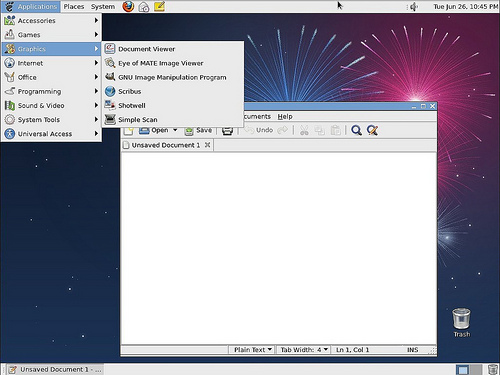Fedora Linux 18 beta finally released


Fedora 18, Red Hat's community Linux distribution, may have an odd name, “Spherical Cow," but with the GNOME 2.x fork, MATE, it may also be the most user-friendly version in years.
Fedora, a cutting-edge Linux distribution, has long been known for championing the unpopular GNOME 3.x Linux desktop interface. While GNOME is showing signs of returning to a friendlier interface, other old-style GNOME 2.x like interfaces such as Cinnamon and MATE have grown in popularity. Now Fedora's developers, seeing which way the wind is blowing, is also supporting MATE.
According to the official Fedora MATE page, all of MATE's packages have been approved and pushed to Fedora 18. The Fedora MATE project owner, Dan Mashal, stated, "MATE is a traditional Gnome 2 like desktop user interface. Many users have expressed interest in this feature since Fedora 15 in which Fedora was switched from Gnome 2 to Gnome 3."
Mashal believes MATE is ideal "For the advanced user that doesn't want a cutting edge desktop and just wants to keep it simple this is perfect for them. The popularity of MATE Desktop is very high. It is one of the 2 choices of DE's [Desktop environments] for Linux Mint, which is one of the most popular Linux distros out right now."
MATE, however, is not installed by default. Fedora's MATE site says all you'll need to add it by running the following command as the root user from a terminal:
yum install @mate-desktop
and that may be true someday. For today, I'm finding installing MATE properly to be really painful and I don't have any easy way for you do it yourself. Hopefully, the Fedora team will get this fixed sooner than later.
As always, this new Fedora release represents the upstream for Red Hat Enterprise Linux (RHEL), Red Hat's enterprise operating platform. It's the community research and development lab, where code changes and innovations often form the basis for other Red Hat open-source projects. This means Fedora always includes the newest open-source software. In turn, this means that Fedora isn't the most stable distribution. That makes Fedora ideal for developers pushing Linux's envelope but it may not be for someone who wants the most reliable platform.
So, Red Hat encourages hard-core Linux users "to download the beta release of Fedora 18, take it for a test drive and help identify items that need attention before Fedora 18 is delivered for general availability. With the beta release, the software is relatively stable, but real-world use and reports from users helps identify any lingering bugs so they can be addressed before it is more widely distributed."
The Fedora beta took its own sweet time in arriving. It should have shown up on September 18 but it was delayed no fewer than six times since then. This was because of major rewrite of Fedora's Anaconda software installation and update program. According to Robyn Bergeron, Red Hat's Fedora Project Leader, this "was a one-time aberration." The final release of Fedora 18 should now arrive on Jan. 8, 2013.
Beside the major Anaconda update and the inclusion of MATE, Fedora 18 will also include the following features:
For users everywhere:
- Fedora 18 offers a brand-new version of the Gnome desktop, version 3.6, straight from the upstream development process. Updates have also been made to the KDE, XFCE and Sugar desktop environments.
- Fedora's new installer user interface enhances the anaconda installer with improvements in ease of use and installation.
For developers:
- This release includes several language updates, including the move to Perl 5.16, updating the Python 3 stack from 3.2 to 3.3, Rails 3.2 and updated D and Haskell programming environments.
For system administrators:
- Fedora 18 includes the final release of Samba 4, and can be used on an Active Directory domain out of the box. An integrated, new native management software allows you to access data and server information easily.
- OpenStack in Fedora 18 has been updated to Folsom, the most recent release by the OpenStack community. This Infrastructure-as-a-Service (IaaS) platform enables the creation and management of cloud infrastructure.
- Eucalyptus 3.1, another IaaS platform, is available in Fedora for the first time, and includes the major components of Eucalyptus.
- Storage System Management CLI tools simplify the user interface by providing unified abstraction and interface for multiple storage technologies, including lvm, btrfs and md raid.
Related Stories: